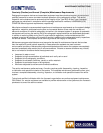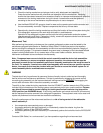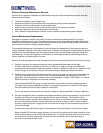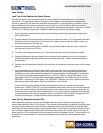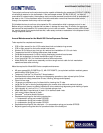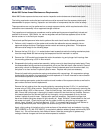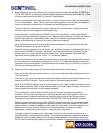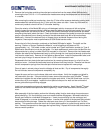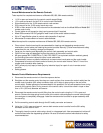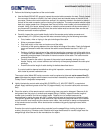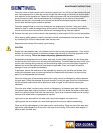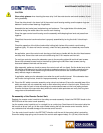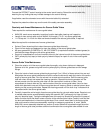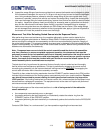
MAINTENANCE INSTRUCTIONS
4.9
7 Remove the front plate containing the outlet port mechanism from the empty Model 880 device by
removing the four 5/16-18 x 1½ in socket button-head screws using the tamperproof tool bit mounted
in a ratchet.
After removing the outlet port mechanism, clean the ‘S’ tube of the exposure device by pushing cloth
swabs wetted with solvent through the ‘S’ tube until they come out clean. Use a dry cloth swab to
remove any residual solvent from the ‘S’ tube after cleaning.
Clean the exterior of the Model 880 using a mild detergent solution to remove all dirt and grime.
Visually inspect the exposure device’s stainless steel end plates for weld failures (cracks, etc.) on the
locking mechanism and outlet port ends. Ensure the handle, the bottom contact surfaces and sides
comprising the plastic jacket are intact. Check the bottom surfaces of the jacket to ensure the contact
area is not excessively worn allowing contact of the stainless steel body with a flat work surface.
Additionally, if dents to the device’s body or flanges due to accidental drops are found during this
inspection, these repairs must be performed at a QSA Global service center.
Ensure that all of the information contained on the Model 880 label is legible. The trefoil and the
warning, ‘Caution or Danger, Radioactive Material’, must be legible at a distance of 3 ft
(approximately 1 m). The model number, serial number and Type B certification number (or Type A
Specification identification) must also be legible. For label replacement, remove the old label from the
exposure device by using a number 30 drill-bit mounted in a hand drill. Remove the rivet heads used
to fasten the label to the stainless steel body by drilling through the rivet head just enough to allow the
rivet head to rotate freely. Remove all rivet heads to remove label. Install the replacement label, andl
and use a pop-rivet gun to secure the new 1/8 in x 3/16 in stainless steel rivets.
Disassemble the front plate (outlet port mechanism) by removing the set screw (or roll pin) from the
outlet port cover. Unscrew the two socket head cap screws from the pivot disk. Remove and discard
the two compression springs from the outlet port mechanism and replace with new springs.
Clean all parts in solvent using a brush to dislodge all dust and dirt. Dry all components thoroughly.
Do not lubricate, leave all components completely dry.
Inspect for wear and burrs on the brass slider and rotor surfaces. Verify the tungsten port shield is
not loose within the rotor. If the port shield is loose, remove the set screw, apply Vibratite
TM
thread
sealant and retighten the set screw against the tungsten port shield. If the port shield uses a roll pin,
remove the roll pin and replace. Inspect the front plate’s outlet port for wear and burrs where the
source guide tube bayonet fitting engages.
Install new compression springs and assemble the outlet port mechanism. Apply Vibratite
TM
thread
sealant to the socket head cap screws before tightening. Install a new set screw to the outlet port
cover.
After assembly of the front plate, perform the following safety function tests using a bayonet source
guide tube fitting. Pull the outlet port cover and rotate clockwise 90 degrees. Movement should be
smooth and limited to a clockwise 90 degree turn. Insert a bayonet fitting into the outlet port and
rotate 90 degrees in a counter-clockwise direction. Insertion and rotation of the bayonet fitting should
be smooth and without snags. Rotate the outlet port cover from a 3 o’clock position to a 5 o’clock
position. This operation moves the rotor from the port shield position to a pass through section of the
rotor. Reverse the operation to disengage the bayonet fitting. Repeat the function test three times to
ensure smooth operation.



